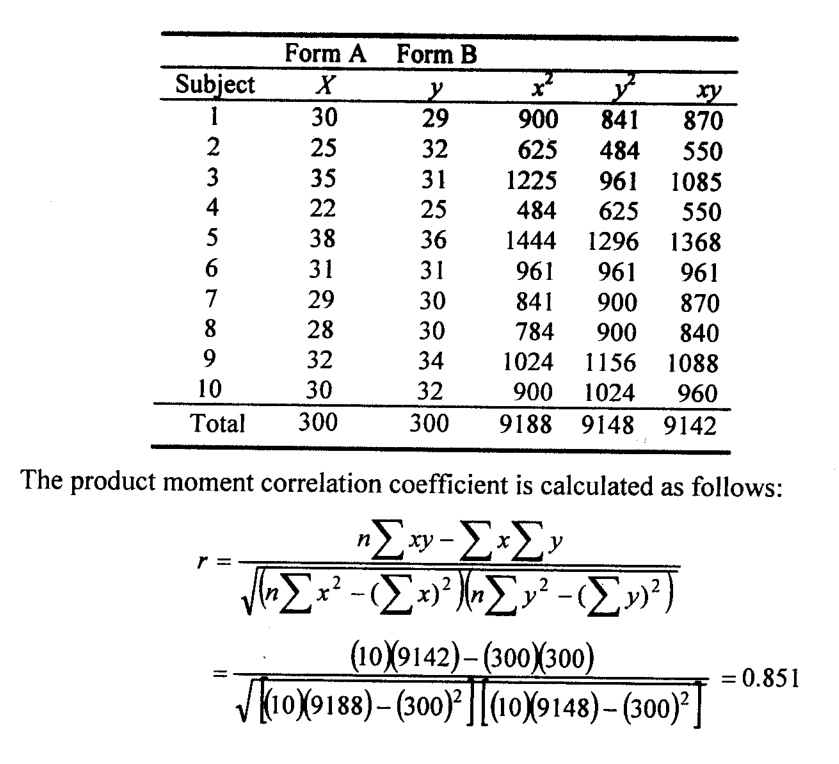In the parallel-forms method, two equivalent tests contain the same kinds of items of equal difficulty, but not the same items are administered to the same individuals. This technique is also referred to as the method of equivalent forms.
We illustrate the computation and interpretation of parallel form reliability with another example due to Sprinthall.
As the name applies, the technique uses two parallel forms, A and B, and these are administered to the same group, one test immediately or fairly soon following the other.
The two test forms of the same test are said to be parallel or equivalent because they are made up of the same types of items covering the same materials or information.
These forms are so made that if one form correlates to a certain extent with other measures, the other form also correlates to the same degree.
Pearson’s product-moment correlation coefficient (r) is computed to find the degree of equivalence between these two forms. The computed coefficient is called the coefficient of equivalence.
Suppose, for example, the scores of 100 persons on two equivalent forms, “A” and “B” of a ‘word fluency test’ were correlated.
In form “A,” the persons were given five minutes to write as many words as they could that began with a given letter, say, ‘s.’
The form “B”t was identical to “A,” except a different letter, say, ‘r’ was employed.
For this purpose, the experimenter chose the two letters as being approximately equal in difficulty. A correlation coefficient can then be computed, and its statistical significance is tested.
Example of Parallel Forms Method
The Sound Recognition Test is a test for a condition known as auditory agnosia, or a person’s ability to recognize familiar environmental sounds, such as a bell, a whistle, or crowd sounds.
There are two forms of the test, A and B, with 13 items per test. Scoring is based on allowing up to 3 points per item, making 39 the highest possible score.
A group of normal, five-year-old children was selected and given form A.
Then, the next day, they were given form B. The accompanying table shows the data and the scheme for calculating the reliability coefficient.

With 8 df, the product-moment correlation coefficient r is significant at the 5% level (a table value of .632 is required). Thus the parallel form reliability is established.
Under the test-retest method, data were regularly collected under system-1 by the registrar.
This system was referred to as a ‘test.’ Under system-2, the supervisors collected retrospective data for the last three months, which they called retest.
We now turn to discuss internal consistency techniques.
These techniques are referred to as the internal consistency techniques because what is being assessed in this case is the consistency that occurs within the test rather than between two administrations of the same test or separate administration of the alternate forms.
The methods to be discussed are
What is Parallel Forms Reliability?
Parallel forms reliability, also known as alternate forms reliability, is a measure of reliability used in psychometric testing to assess the consistency of results obtained from different test versions intended to measure the same construct.
How is Parallel Forms Reliability established?
To establish parallel forms reliability, two or more different versions of a test are created, each containing different items but designed to assess the same underlying construct. The reliability coefficient is calculated by administering both forms of the test to a sample of individuals and correlating their scores on the two forms
What are the methods used to establish Parallel Forms Reliability?
Common methods include the Split-Half Method, where a single test is split into two halves and their scores are correlated; the Equivalence of Form Method, where two different forms of a test are administered and their scores are correlated; and the Counterbalancing Method, where multiple forms are administered to different subgroups of participants in a counterbalanced order.
How does Parallel Forms Reliability differ from Split-Half Reliability?
While both assess the consistency of a test, parallel forms reliability involves administering two different forms of a test to the same group of participants, whereas split-half reliability involves splitting a single test into two halves and correlating the scores of the two halves.
What are the advantages of Parallel Forms Reliability?
Parallel forms reliability can avoid problems inherent with test-retesting and ensures that changes in scores are reflective of the construct being measured rather than due to practice effects or familiarity with the items.
What are the potential drawbacks of Parallel Forms Reliability?
Challenges in developing truly parallel forms, the time and resources required for creating multiple test versions, and the potential for order effects are some limitations. Additionally, there’s no guarantee that the two test versions are equivalent in difficulty.
In what situations is Parallel Forms Reliability commonly applied?
It is used in test development, to counteract practice effects, for equivalence across languages or cultures, in experimental manipulations, educational testing, psychometric testing, clinical assessments, cross-cultural research, experimental studies, and personnel selection.